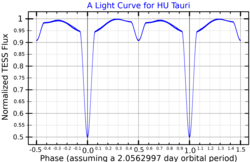| Observation data Epoch J2000.0 Equinox J2000.0 | |
|---|---|
| Constellation | Taurus |
| Right ascension | 04h 38m 15.830s[2] |
| Declination | −19° 05′ 32.96″[2] |
| Apparent magnitude (V) | 5.85[3] |
| Characteristics | |
| Spectral type | B8V + G2IV[4] |
| B−V color index | −0.019±0.007[5] |
| Variable type | Semi-detached Algol variable[3] |
| Astrometry | |
| Radial velocity (Rv) | −2.3±4.3[6] km/s |
| Proper motion (μ) | RA: −12.899 mas/yr[2] Dec.: −7.198 mas/yr[2] |
| Parallax (π) | 7.8722 ± 0.0466 mas[2] |
| Distance | 414 ± 2 ly (127.0 ± 0.8 pc) |
| Absolute magnitude (MV) | 0.83[5] |
| Orbit[7] | |
| Period (P) | 2.0563056 d |
| Eccentricity (e) | 0 (assumed) |
| Periastron epoch (T) | 2,446,487.5 HJD |
| Semi-amplitude (K1) (primary) | 59.3±0.85 km/s |
| Semi-amplitude (K2) (secondary) | 231.2±2.2 km/s |
| Details[7] | |
| Primary | |
| Mass | 4.43±0.09 M☉ |
| Radius | 2.57±0.03 R☉ |
| Luminosity | 123 L☉ |
| Surface gravity (log g) | 4.26±0.014 cgs |
| Temperature | 12,000±1,000 K |
| Rotational velocity (v sin i) | 80 km/s |
| Secondary | |
| Mass | 1.14±0.03 M☉ |
| Radius | 4.21±0.03 R☉ |
| Luminosity | 8.3 L☉ |
| Surface gravity (log g) | 3.48±0.014 cgs |
| Temperature | 5,740±150 K |
| Other designations | |
| Database references | |
| SIMBAD | data |
HU Tauri is a tight binary star system in the equatorial constellation of Taurus. It is an eclipsing binary, which means that the member stars periodically eclipse each other every 2.056 days. They have a combined apparent visual magnitude of 5.85,[3] which is bright enough to be dimly visible to the naked eye. During the primary eclipse, the magnitude drops to 6.68, while the secondary eclipse decreases the magnitude to 5.91. The distance to this system, based on parallax measurements, is approximately 414 light years.[2]
The variable nature of this system was reported by W. Strohmeier and R. Knigge in 1960. In 1963, Strohmeier found a period of 2.056297 days, and A. Mammano and associates derived orbital elements for a single-lined spectroscopic binary in 1967. A light curve for the system was assembled by O. Tümer and M. Kurutaç in 1979.[9] M. Parthasarathy and M. B. K. Sarma in 1980 noted asymmetries in the light curve near the primary eclipse, which suggested gas streams are partially obscuring the light from the primary component.[10]
This is a semidetached binary system with an orbital period of 2.0563056 days in an essentially circular orbit. The primary component is presently a B-type main-sequence star with a stellar classification of B8V. It has 4.4 times the mass and 2.6 times the radius of the Sun.[7] The primary eclipse is an occultation in which the secondary completely covers the primary. The cooler and larger secondary star is over-luminous for its mass, indicating that it has evolved away from the main sequence, and is filling its Roche lobe. The spectrum of the system suggests that the secondary is undergoing mass loss, with a gas stream transferring matter to the primary.[11]
- ^ Cite error: The named reference
MASTwas invoked but never defined (see the help page). - ^ a b c d e Cite error: The named reference
GaiaEDR3was invoked but never defined (see the help page). - ^ a b c Cite error: The named reference
Samus_et_al_2017was invoked but never defined (see the help page). - ^ Cite error: The named reference
Eggleton2008was invoked but never defined (see the help page). - ^ a b Cite error: The named reference
Anderson_Francis_2012was invoked but never defined (see the help page). - ^ Cite error: The named reference
Gontcharov2006was invoked but never defined (see the help page). - ^ a b c Cite error: The named reference
Maxted_et_al_1995was invoked but never defined (see the help page). - ^ Cite error: The named reference
SIMBADwas invoked but never defined (see the help page). - ^ Cite error: The named reference
Tumer_Kurutac_1979was invoked but never defined (see the help page). - ^ Cite error: The named reference
Parthasarathy_Sarma_1980was invoked but never defined (see the help page). - ^ Cite error: The named reference
Parthasarathy_et_al_1995was invoked but never defined (see the help page).
